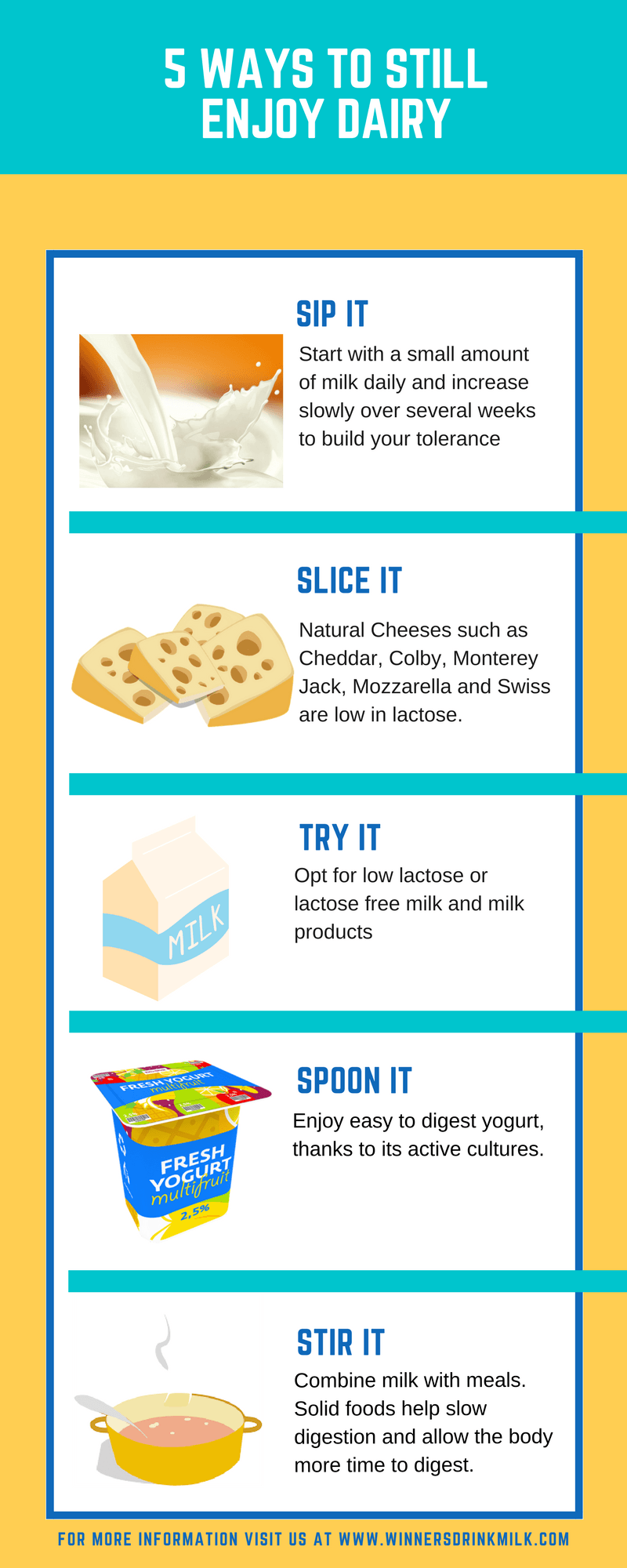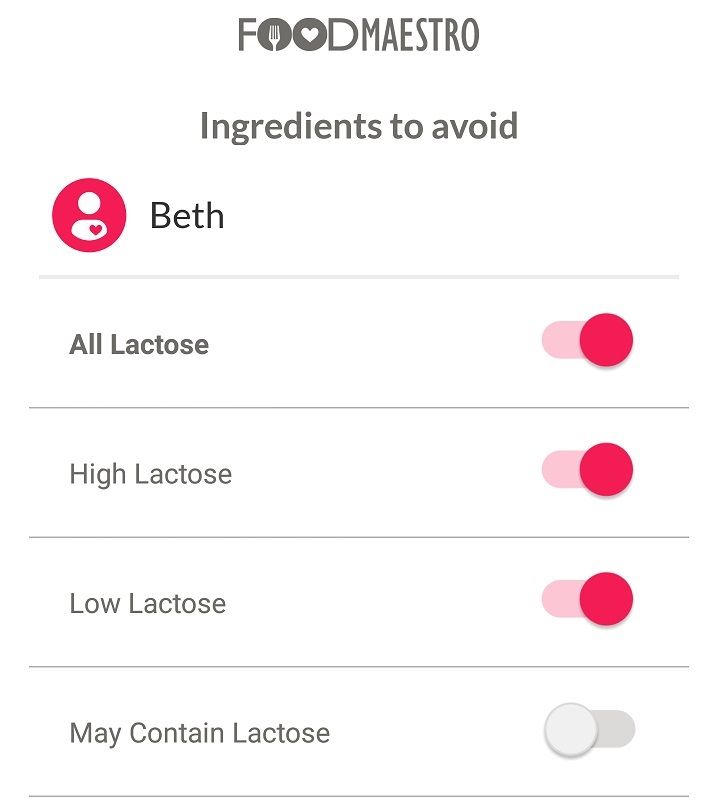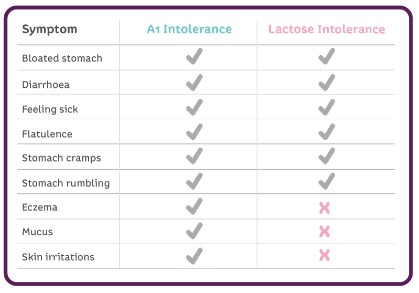40 reading labels for lactose intolerance
Lactose intolerance - foods to eat and foods to avoid ... Foods to avoid if you have lactose intolerance. Milk and milk products are listed on product labels in a variety of ways. These ingredients should be avoided if they exacerbate your symptoms of lactose intolerance. Always read the labels before purchasing an item. Ingredients to look for: whey; milk; curds; nonfat dry milk powder; lactose; dry ... Lactose Intolerance: Symptoms, Causes, and Treatment ... Learn more about the signs and symptoms of lactose intolerance and how to treat it. ... During these 30 days, be sure to read labels carefully, as dairy products are hidden in many packaged foods. If symptoms decrease or disappear during these 30 days, but reoccur when you have reintroduced dairy into your diet, this is a strong sign that you ...
Understanding Food Labels - Go Dairy Free Food labels can be confusing, especially when special diets and food allergies come into play. ... recommendations and health guides to aide those with milk allergies, lactose intolerance or a general need or desire to live without dairy. Dairy-free does include milk-free, lactose-free, casein-free and whey-free, too! We also offer ample ...

Reading labels for lactose intolerance
Food Labels | Lactose Intolerance Although some products may not have a label that clearly states "may contain lactose" or "does not contain lactose.". The first thing to do when you encounter a food label, look for the amount of sugar it contains. If it has less than 0.5 grams of sugar then it should be fine. If the label reads that more than 1 gram of sugar then it ... Lactose Intolerance | Allergy UK | National Charity Diagnosis of lactose intolerance Diagnosis of lactose intolerance is usually made if the symptoms get better after excluding all sources of lactose from the diet for two weeks and this involves carefully reading food labels. Lactose rich foods are then re-introduced into the diet and if the symptoms come back, the diagnosis is confirmed ... Does Havarti Cheese Have Lactose - CheeseProClub.com Yogurts that contain active cultures are easier to digest and much less likely to cause lactose problems. Learn to read food labels. Lactose is added to some boxed, canned, frozen, and prepared foods like bread, cereal, lunchmeats, salad dressings, mixes for cakes and cookies, and coffee creamers.
Reading labels for lactose intolerance. Lactose Intolerance: Symptoms, Diagnosis & Treatments Read the ingredients on food labels What is lactose intolerance? Lactose intolerance is the inability to digest lactose, the sugar primarily found in milk and dairy products. It is caused by a shortage of lactase in the body, an enzyme produced by the small intestine that is needed to digest lactose. Lactose Labeling - Things to Know About Lactose-Free FDA ... Lactose-Free FDA Labels. Since lactose intolerance is not an actual allergy (like a milk, egg, or wheat allergy), there is no FDA definition for lactose-free. However, manufacturers must always be truthful with their ingredients and if a product contains lactose, they must say so on the product label. According to the FDA, lactose-free products ... Lactose Intolerance | HealthLink BC Be sure to read labels for lactose and for lactose's "hidden" names, such as: Dry milk solids. Whey. Curds. Milk by-products. Non-fat dry milk powder. One of the biggest concerns for people who are lactose-intolerant is making sure they get enough of the nutrients found in milk products, especially calcium. Lactose Intolerance Lactose intolerance is when your body can't break down or digest lactose. Lactose is a sugar found in milk and milk products. Read on to learn details about lactose intolerance, including causes, symptoms, diagnosis, and treatments.
PDF My Nutrition Lactose intolerance • Check food/drink labels to identify any added milk or milk products. Milk proteins, ... reading the nutrition information panel. • Have 2-3 serves of dairy/dairy alternatives per day. This may be different depending ... • If you have lactose intolerance, you may be at risk of not getting enough calcium. ... Lactose Intolerance Symptoms, Tests, and Diagnosis To avoid symptoms from lactose intolerance, read food labels carefully. When shopping or cooking, look for these ingredients that have lactose: Curds; Dry milk solids; Milk; Milk byproducts; Lactose Intolerance - Health Encyclopedia - University of ... Lactose is a sugar found in milk and milk products. Lactose intolerance happens when your small intestine does not make enough of a digestive enzyme called lactase. Lactase breaks down the lactose in food so your body can absorb it. People who are lactose intolerant have unpleasant symptoms after eating or drinking milk or milk products. Lactose Intolerance Lactose intolerance is when your body can't break down or digest lactose. Lactose is a sugar found in milk and milk products. Read on to learn details about lactose intolerance, including causes, symptoms, diagnosis, and treatments. ... It's important to read food labels. Lactose is often added to some boxed, canned, frozen, and prepared ...
Label Reading & the FDA | Celiac Disease Foundation The Celiac Disease Foundation Medical Advisory Board supports the <20 ppm of gluten standard for gluten-free labeling. According to Dr. Peter Green, Director of the Celiac Disease Center at Columbia University, "The 20 ppm is a scientifically determined level of gluten that has been shown to be tolerated by those with celiac disease. 3 Easy Ways to Test for Lactose Intolerance - wikiHow 3. Eliminate the milk products from your diet to see if you improve. Stop eating dairy, as well as any other possible sources of lactose, for at least 2 weeks. If you stop having diarrhea, nausea, bloating, gas, and so on, you may be lactose intolerant. You may still want to get tested by a doctor so you know for sure. How to Manage Lactose Intolerance | by HiwaMagOnline | Medium Lactose intolerance is a condition in which people have symptoms due to the decreased ability to digest lactose, a sugar found in dairy products. ... It's important to read labels carefully and ... Lactose intolerance - AGA GI Patient Center Lactose intolerance is when a person is not able to digest a lot of lactose due to a lack of the enzyme lactase. ... Label reading. Lactose-free dairy products (Lactaid milk, lactose-free yogurts, hard cheeses) are made from real dairy and have been treated to reduce the lactose content of the product. Dairy-free products are made from plants ...
Reading food labels - Food Allergy Education The new Plain English Allergen Labelling (PEAL) law means that the common names of food allergens must be listed on a food label. (e.g. the word 'egg' rather than just the protein in egg which is 'albumin'). Food companies need to make these labelling changes by 2026, so up until then you will need to know how to read labels that comply with ...
PDF Managing Lactose Intolerance Managing Lactose Intolerance What is Lactose and Lactose Intolerance? Lactose is a sugar found in some dairy products. Lactase is an enzyme in the ... plan to use one of these, be sure to read the nutrition labels carefully and choose a brand that specifically states it contains calcium and vitamin D. The
Milk Allergy: Products to Avoid, Foods With Milk In Them ... Lactose intolerance is when you can't digest lactose, the sugar found in dairy products. You'll often get symptoms like stomach pain, gas, and diarrhea. With a milk allergy, the symptoms affect ...
The Secrets to Decoding Food Labels for Dairy-Free Living Read this post for more details: Non-Dairy vs Dairy-Free. Milk-Free - It's typically equivalent to dairy-free labels, and should mean the product is made without any milk-based (dairy) ingredients. Lactose-Free - Lactose-free just means the product is free of milk sugar, not of all milk-based ingredients. However, some dairy-free products ...
Fast Five Quiz: Lactose Intolerance Note the following dietary considerations in patients with lactose intolerance: Patients should read labels on commercial products. Patients should avoid or reduce intake of lactose-containing foods. Most patients who are lactose intolerant can ingest as much as 240 mL of milk without an exacerbation of their symptoms. However, some patients ...
Lactose Intolerance | Patient Education | UCSF Health Lactose, a milk sugar, is found primarily in dairy products. It also may be added to foods during manufacturing. Intolerance to lactose is caused by a lack of lactase, an enzyme that breaks down lactose for digestion. Some people produce low amounts of lactase under normal conditions. In general, African-American, Asian and Native American ...
Lactose intolerance: Shopping tips for lactose-intolerant ... People who are sensitive to lactose need to read the labels on food packaging very carefully. Read on to find out what to watch for when shopping and how much lactose is found in different foods. All packaged foods have a label on them with information such as: the best before date,all of the ingredients,ingredients that commonly trigger allergies or food intolerances, andthe nutritional ...

Labelling is designed to highlight products containing milk protein rather than lactose so it is ...
PDF Your quick guide to: Lactose Intolerance intolerance, as lactose is the main sugar in all mammalian milks Certain populations, particularly Asian and African people, often suffer from a genetic ... carefully reading food labels. Lactose rich foods are then re-introduced into the diet and if the symptoms come back, the
Lactose Intolerance - Eatright.org Lactose intolerance is a problem digesting foods that contain lactose. Lactose is a naturally occurring sugar found in dairy products such as milk, yogurt and cheese. Many people are able to have these foods and beverages without problem, but some individuals are unable to break this sugar down. Lactose intolerance runs in families—thus if ...

How to Practice "Love and Logic" Parenting, Session 2: Teaching Kids to Listen... the First Time ...
Lactose Intolerance | Symptoms and Tests | Patient Lactose intolerance is a condition in which the body has difficulty handling lactose. People with this condition may get diarrhoea, stomach pains and bloating if they drink milk or eat dairy products. Some people are born with a tendency to develop lactose intolerance; others get it as a result of gastroenteritis or chemotherapy.
Reading food labels to avoid food allergies and ... In Australia, many allergens must be declared on food labels regardless of the amount present. This includes ingredients that may be classed as processing aids e.g. flour used to coat moulds. Allergens that must be declared by law are milk, egg, soy, wheat, fish, seafood, tree nut and peanut. A variety of terms can be used to identify ...
Does Havarti Cheese Have Lactose - CheeseProClub.com Yogurts that contain active cultures are easier to digest and much less likely to cause lactose problems. Learn to read food labels. Lactose is added to some boxed, canned, frozen, and prepared foods like bread, cereal, lunchmeats, salad dressings, mixes for cakes and cookies, and coffee creamers.
Lactose Intolerance | Allergy UK | National Charity Diagnosis of lactose intolerance Diagnosis of lactose intolerance is usually made if the symptoms get better after excluding all sources of lactose from the diet for two weeks and this involves carefully reading food labels. Lactose rich foods are then re-introduced into the diet and if the symptoms come back, the diagnosis is confirmed ...
Food Labels | Lactose Intolerance Although some products may not have a label that clearly states "may contain lactose" or "does not contain lactose.". The first thing to do when you encounter a food label, look for the amount of sugar it contains. If it has less than 0.5 grams of sugar then it should be fine. If the label reads that more than 1 gram of sugar then it ...











Post a Comment for "40 reading labels for lactose intolerance"